What does it take to complete the Tour de France?
Maria David gets a vivid insight into the demands of the race from a team of amateur women who completed the full route one month ahead of the pros
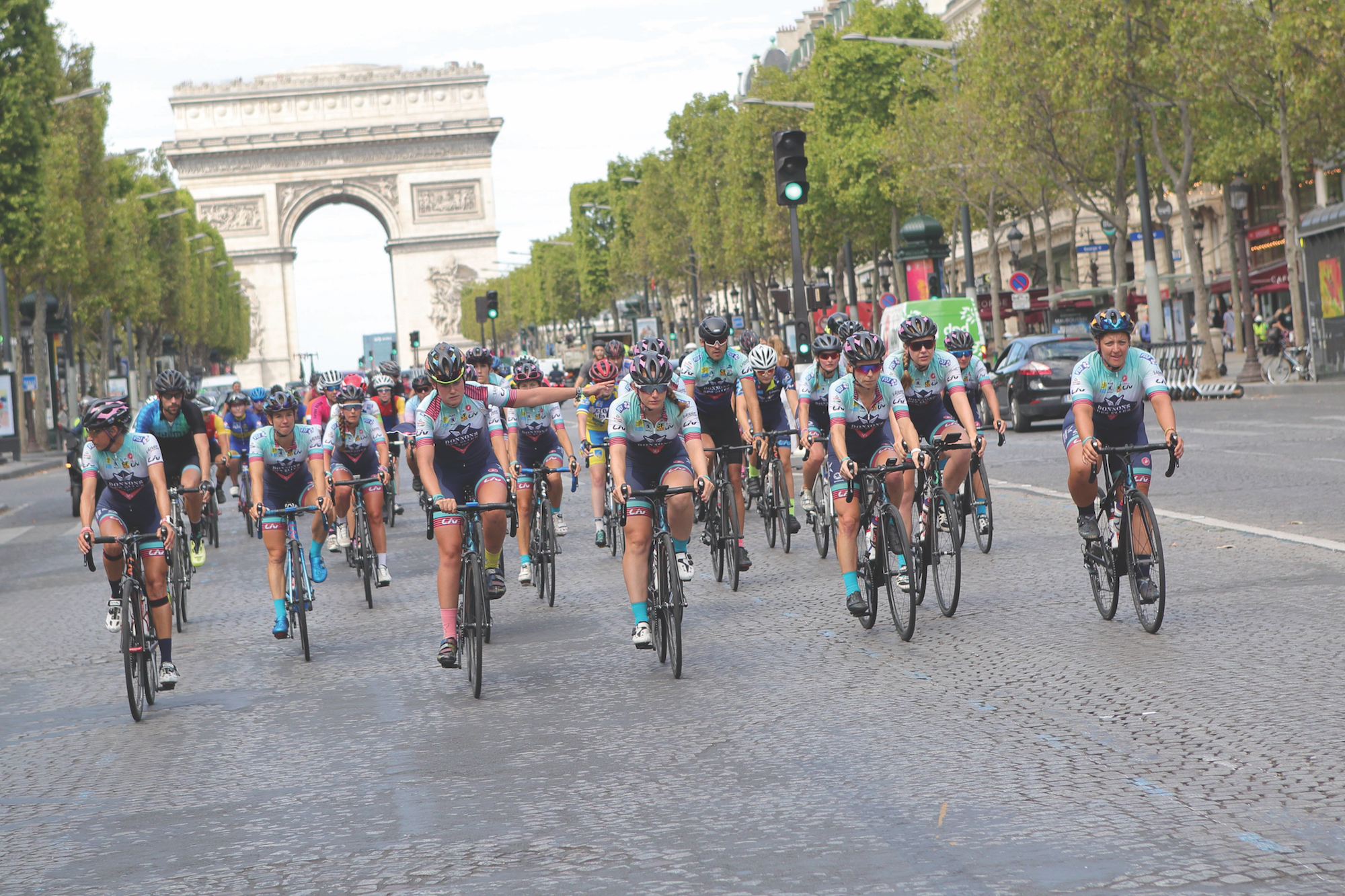
(Marie Istil)
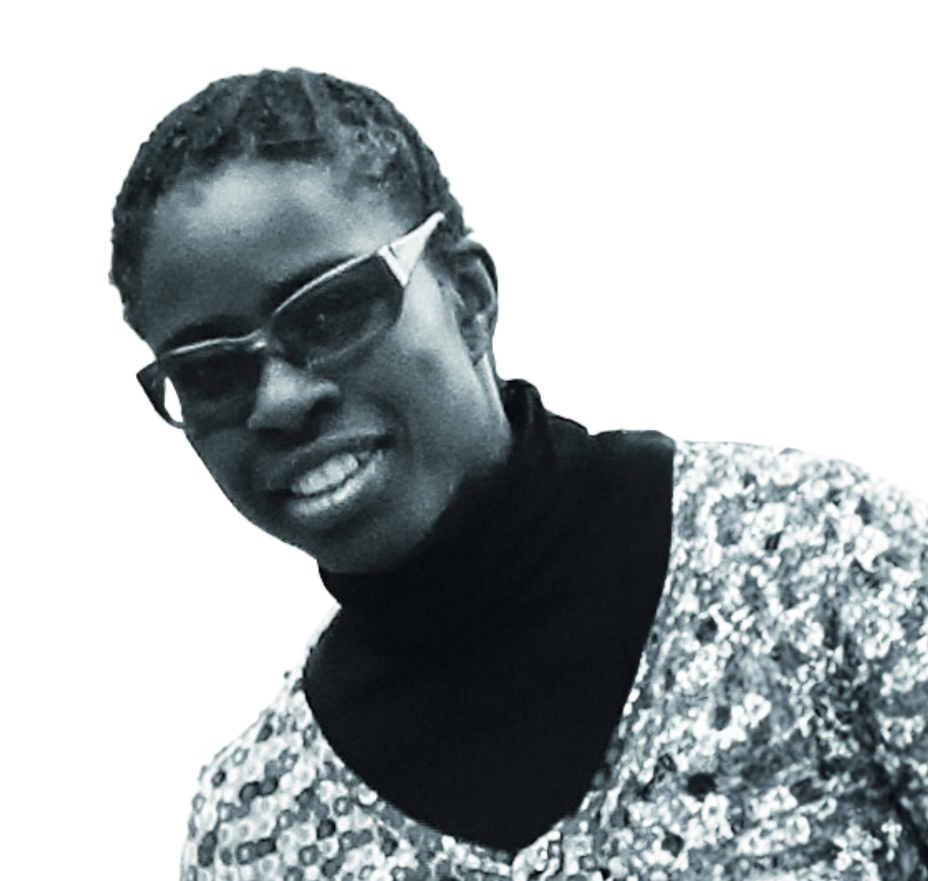
What does it really take for Joe or Jill Bloggs – normal amateur riders – to complete the full route of this year’s Tour de France? We don’t need to speculate, because a group of amateur women have just returned home from doing just that.
Each year for the last six years, international team Donnons des elles au Vélo has ridden the route of the Tour de France as part of their campaign calling for a women’s Tour de France, while raising the profile of women’s cycle racing. The team consists of 13 riders, selected from around 100 applicants. Guests (men and women) can accompany the group on the rides, though it is the women’s team that takes centre stage. In a normal year, they ride each stage one day ahead of the pros, but due to the pandemic, this year’s ride took place one month ahead.
The women trained specifically for the Tour route over eight months, despite being constrained by lockdown. One of the riders, Claire Floret, suffered from Covid-19 symptoms, leaving her with neurological issues including loss of taste and depression. Other participants – Magali Lagarde, Soléne Marquet and Valerie Jeudy worked on the frontline as nurses, juggling training with the demands of their job – it didn’t stop them from covering thousands of kilometres in preparation for the challenge.
Stage 1
Nice to Nice via Castaigners – 155km
Type: Flat
Difficulty rating: ★★
Get The Leadout Newsletter
The latest race content, interviews, features, reviews and expert buying guides, direct to your inbox!
Laura Lestingi says: “We were full of enthusiasm to be finally starting our ride. Our legs felt good, but we took it easy, mindful of the tough stages that lay ahead.”
Stage 2
Nice to Nice via Col de Turini – 187.7km
Type: Mountain
Difficulty rating: ★★★★
Highlight: Descending Col de Turini
Hardest part: Climbing col d’Eze and Col des Quatre Chemins in the heat twice
What did it take?
“The main climb, Col de Turini, was a seven per cent gradient over 15km. I had stomach problems and struggled to digest my food. The discomfort went away after the climb, and it was a great descent. But when we went into the Col d’Eze, things got tougher. Although it is not a tough climb, it came at the end of the day of 38ºC heat, and it was demoralising going up Col d’Eze descending into Nice and then having to climb back up it again.
“Other women had stomach problems too. The problem was that having Alpine climbs so early, meant our bodies had not had the chance to adapt to the greater work and digestive load. It was a beautiful stage, but the last part was quite challenging because of the heat, as well as having to negotiate the rush hour traffic in Nice.”
Lestingi’s data:
Distance: 186km
Elevation gain: 3,393m
Calories: 6,001kcal
Max speed: 72kph
Stage 3
Nice to Sisteron – 202km
Type: Flat
Difficulty rating: ★★
Valerie Jeudy says: “After the tough stage in Nice, we were caught out, thinking this would be an easy stage along the historic Route Napoleon. However, we were climbing for the first 120km, with temperatures reaching 42ºC.”
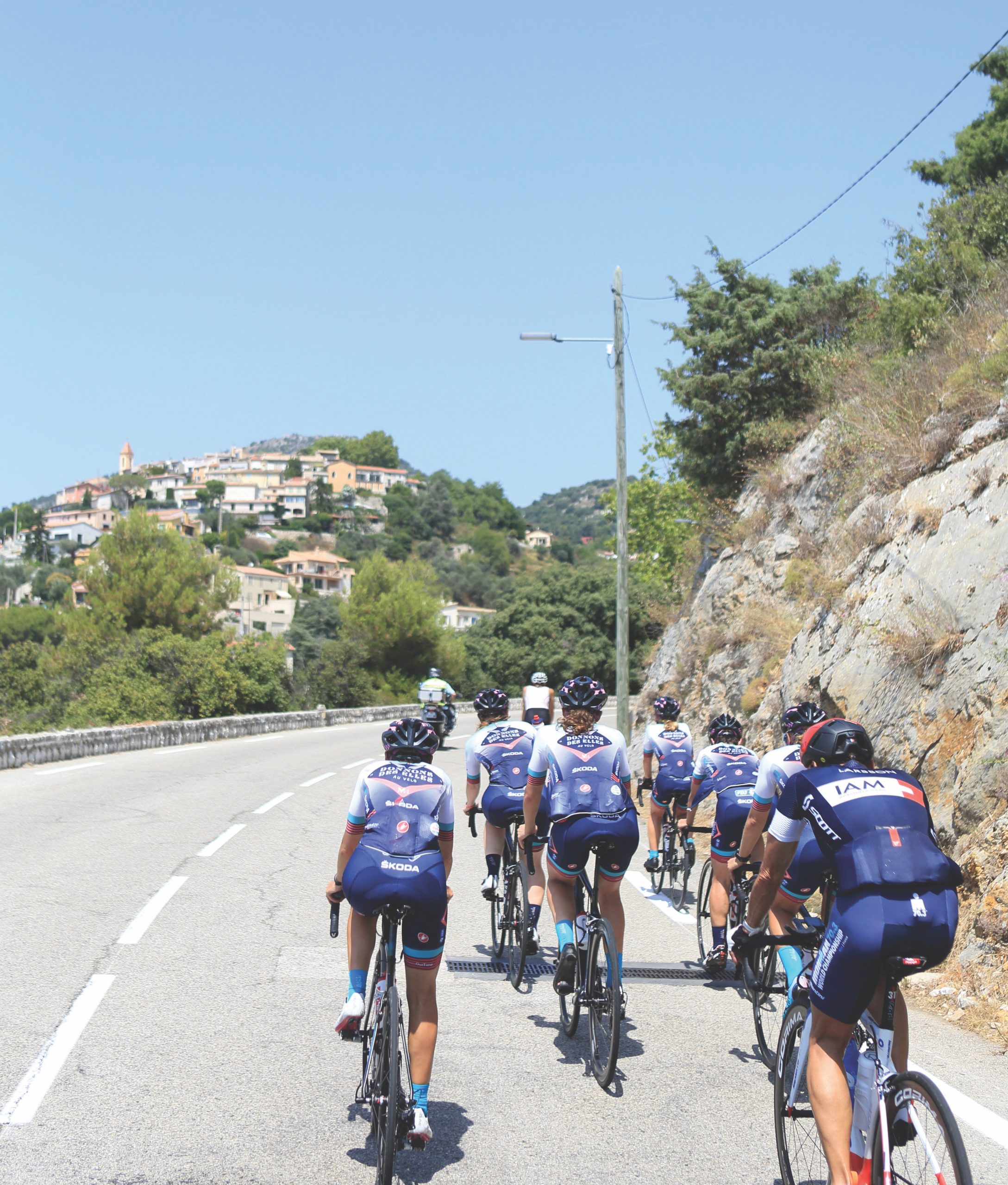
Stage 4
Sisteron to Orcières-Merlettes – 163.5km
Type: Hilly
Difficulty rating: ★★★
Claire Floret says: “This was one of the most memorable stages because of the
welcome we received as we climbed up to the ski resort. Hundreds of townsfolk and the local council turned out to cheer us on. It was emotional.”
Stage 5
Gap to Privas – 183.5km
Type: Flat
Difficulty rating: ★
Ofélie Tastavin says: “A mainly downhill stage where we finished ahead of schedule. This allowed us time to have a massage from one of the five sports therapists accompanying us.”
Stage 6
Le Teil to Mont Aigoual – 190.9km
Type: Hilly
Difficulty rating: ★★
Céline Lauret says: “A mainly flat stage, apart from a 17 per cent gradient on Col de la Lusette. At least it wasn’t in blazing heat, phew!”
Stage 7
Creissels to Lavaur – 167.9km
Type: Flat
Difficulty rating: ★★
Coraline Conan says: “The last 70km were either downhill or flat, but
required focus because the fatigue was catching up with us as we rode in a moderate wind.
“Given that we weren’t getting to bed before midnight each night and then waking up at 6am, sleep deprivation was setting in.”
Stage 8
Cazères-sur-Garonne to Loudenvielle – 142.8km
Type: Mountains
Valerie Jeudy says: “Our first day in the Pyrenees, with three categorised climbs. We took things steadily.”
Stage 9
Pau to Laruns – 160km
Type: Mountains
Difficulty rating: ★★★★
Highlight: Having my brother ride with us and motivate me
Hardest part: Climbing the Col de Marie Blanque
What did it take?
“I knew this would be a tough day because of the climbs and the heat, so I mentally prepared myself for it. I made sure to eat well: I had a big breakfast with bread and jam, plus cereal. During a stage, I generally eat every two hours. We have a break at mid-morning, and mid-afternoon as well as a lunch stop, so that keeps my energy levels up. I also keep Clif Bars in my pocket.
“At lunch, the staff gave us chicken sandwiches, and we dipped our feet in a stream to cool down. I didn’t want to ride too easy on the early climbs, as I wanted to keep a good rhythm and not let my legs go to sleep. As an ultra-distance rider, I function better if I don’t ride too slowly – and I didn’t mind riding harder before the rest day.
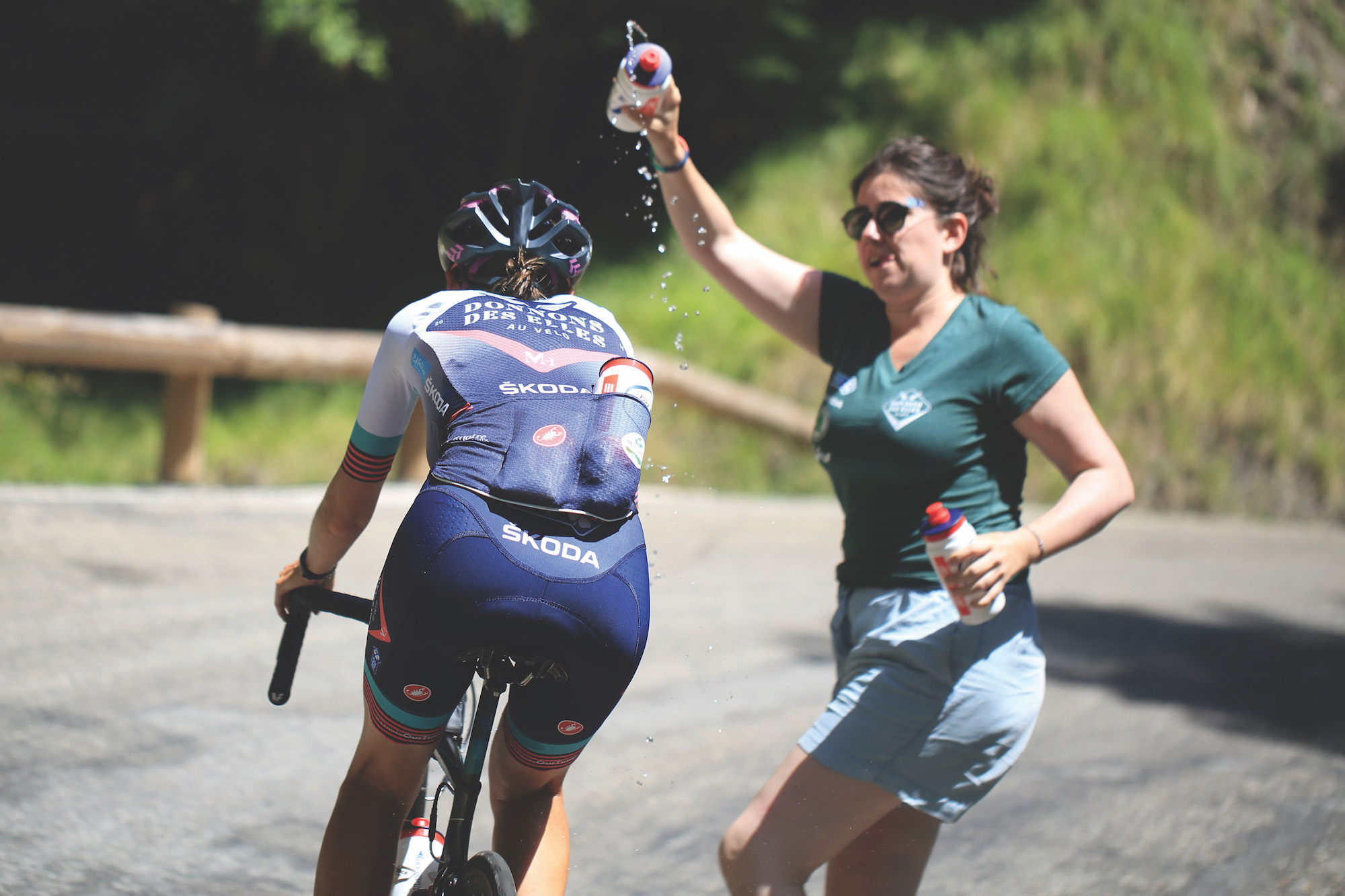
“I was familiar with Col de Soudet, and had ridden Col de Marie Blanque from Bielle in the past. But riding it towards Laruns was a lot harder, and the last 4km had ramps of over 12 per cent. I followed the wheel of some of the better climbers – Solène and Aline [Clément], who were just ahead of me. My brother rode with us and that motivated me to try harder. A women’s group, Extra Miles, also joined us and that gave an increased feminine presence on the road.”
Geneau’s data
Distance: 158.5km
Elevation gain: 3,200m
Calories : 2,820kcal
Maximum power: 945W
Maximum speed: 70kph
Stage 10
Le Château-d’Oléron – Saint Martin de Re – 169km
Type: Flat
Difficulty rating: ★
Nathalie Giloy says: “A pan-flat stage between two spectacular promontories. It’s normally a windy stage and echelons form, but luckily today was unusually calm.”
Stage 11
Angoulins to Poitiers – 167km
Type: Flat
Difficulty rating: ★
Caroline Soubayroux says: “This flat, monotonous stage was easy on the legs, but hard on the morale. On these days, it is better to ride at the back of the group and chat to the guest riders to pass the time.”
Stage 12
Chauvigny to Sarran Corrèze – 222km
Type: Hilly
Difficulty rating: ★★★
Highlight: Crossing the finish line!
Hardest part: Suc de Mary
What did it take?
“This was the longest stage and was approached with trepidation, as it was a constant succession of ups and downs, with the toughest climbs towards the end. This type of stage is harder than Alpine stages where you have a long climb and a long descent to recover. Today the descents weren’t long enough to recover, and we were always working. I am a rouleur-puncheur rider, but with all the efforts we had done so far, this stage was a stretch for me.
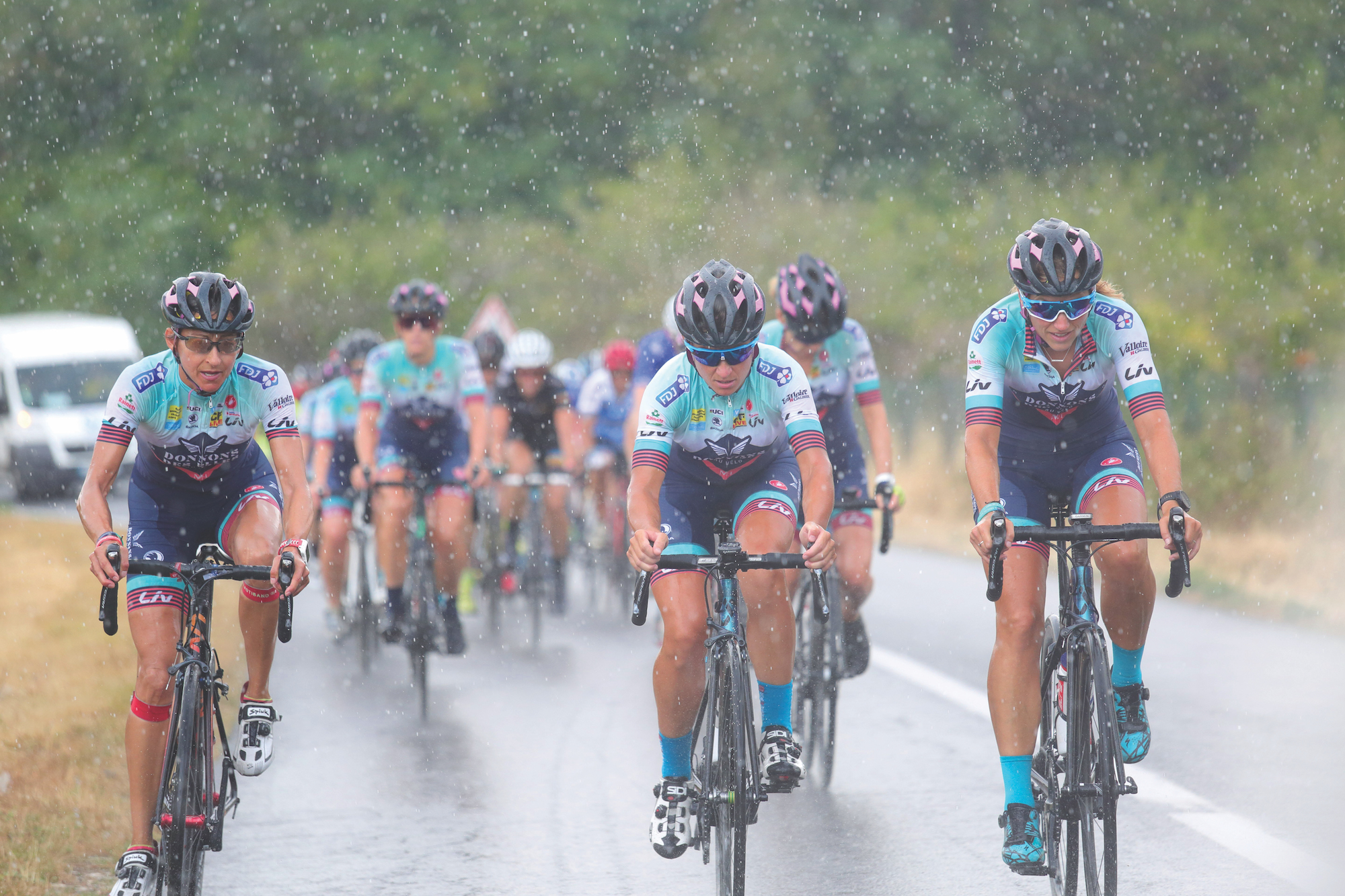
“At 50km in, we got soaked to the skin after a violent storm, and didn’t dry out for the rest of the day. It was tough riding through-and-off into the wind, and after 200km, with heavy legs we tackled the Suc de Mary, which felt like riding up a wall. It was a real test on our motivation. On our arrival in Corrèze, we were welcomed by the local councillor who rewarded us with a free visit to the Jacques Chirac Museum!”
Giloy’s data:
Distance: 222km
Elevation gain: 3,824m
Calories: 3,627kcal
Maximum power: 617W
Maximum speed: 63kph
Stage 13
Chatel Guyon to Puy Mary
Type: Medium mountains
Difficulty rating: ★★★
Highlight: Seeing all our names written on the road on the climb to Puy Mary
Hardest part: Summit finish on Puy Mary
What did it take?
This stage went through Auvergne over the ancient lava domes (or Puy). Although there are no cols, the area is constantly undulating with six climbs to crest. Yesterday was the longest stage of the day, while today had the most climbing: 4,400m. Puy Mary had some 15-16 per cent ramps in the last 3km. The encouragement by the spectators on the climb was the thing that kept us going, and it was particularly emotional for me, as this is my home region.
“I started cycling just two years ago, after 15 years as a basketball player, and hadn’t expected my application to be accepted. Many people helped me prepare by doing 200km rides and cyclosportives with me. I also did intervals on the turbo trainer and did crossfit online with my teammates.
“As a nurse, I had to deal with the difficult mental aspects of working on the front line, and sport was a good distraction, even if I didn’t enjoy training indoors. Lockdown limited my training, and I didn’t feel sure that I could ride 200km stages day after day. But today’s stage went well for me, thanks to the encouragement.”
Marquet’s data:
Distance: 194km
Elevation gain: 4,232m
Calories: 7,425kcal
Max speed: 60kph
QOMs gained: 3
Stage 14
Clermont Ferrand to Lyon – 203km
Type: Flat
Difficulty rating: ★★
Coraline Conan says: “We were quite euphoric and got a morale boost after Christian Prudhomme came to see us and congratulated us on our ride. He said that our efforts had contributed towards ASO deciding to organise a women’s stage race in 2022. Our ride was interrupted on the Col du Béal when we had to give way to the pro riders doing this route as Stage 1 of the Critérium du Dauphine Libéré.”
Stage 15
Vaulx-en-Velin to Grand Colombier – 176km
Type: Mountain
Difficulty rating: ★★★
Highlight: The view of the Lac du Bourget
Hardest parts: Riding Montée de la Selle de Fromentel; Grand Colombier
What did it take?
“This was my worst stage. As a road racer, I am used to 60km crits. I train six times per week, doing rides in the morning and crossfit with Claire [Floret] in the afternoons. I also do long rides, and after lockdown I rode La Route des Grandes Alpes to prepare for this tour. But riding 200km per day for three weeks was a step up for me. By the time we were doing this stage, I had terrible pains in my knees, and achy glutes. The first climb, Montée de la Selle de Fromentel was hell, with the gradient going to 24 per cent. The final climb, Grand Colombier, was less steep, but was the longest. I was also suffering from sleep deprivation – drinking a lot of coffee to get through the days. I really appreciated the upcoming rest day and the chance to get a good massage.”
Claire Floret’s data:
Distance: 180km
Elevation gain: 3,529m
Calories: 3,243kcal
Maximum power: 687W
Maximum speed: 75kph
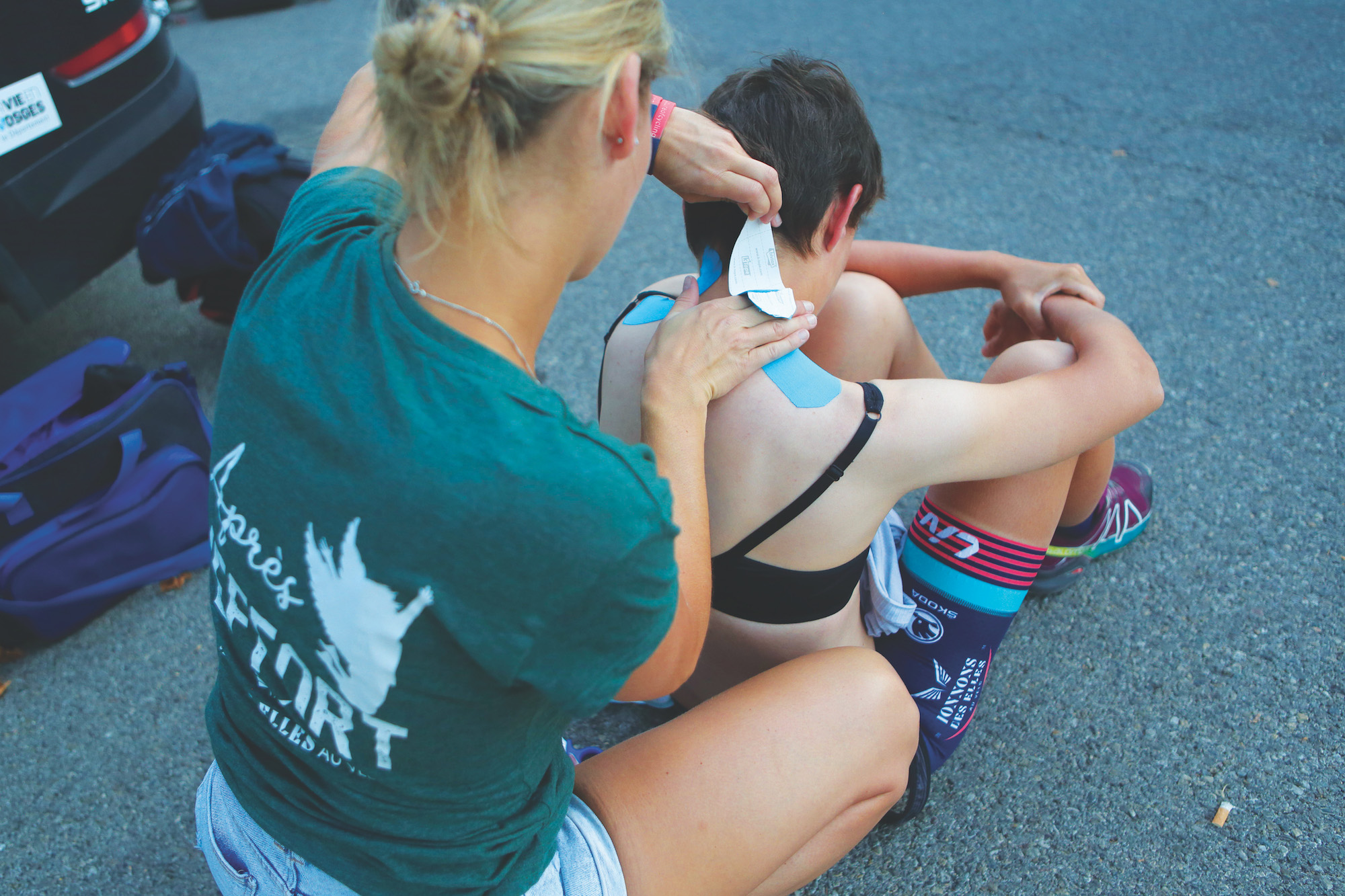
Stage 16
Saint-Didier-de-la-Tour to Villard-de-Lans – 165km
Type: Mountains
Difficulty rating: ★★★
Aline Clément says: “Our legs felt fresh after the rest day for this Alpine stage that included five categorised climbs. It was a day of contrasts, as the morning saw interest from the local television station and the French Cycling Federation, while in the afternoon we were harassed by some male motorists and motorbikers who insulted us from their cars and did close passes.”
Stage 17
Corenc to Col de la Loze – 169km
Type: Mountains
Difficulty rating: ★★★★
Highlight: A can of Coke on Col de la Loze!
Hardest part: Col de la Loze
What did it take?
“I had been looking forward to doing this stage, and wanted to ride it well. However, with all the cumulative miles in my legs, I couldn’t ride it as fast as I would have liked. We’d had a rest day two days before, and it took me time to get back into the rhythm. Rest days are useful, but if I don’t ride at all, my legs get stiff. A mix-up over trucks meant that I couldn’t access my bike on the rest day, so I spent stage 16 trying to get my legs back into pedalling.
“After that long day, I skipped the evening meal, preferring sleep over food. However, I still felt tired and sleepy during this stage, especially on the Col de la Madeleine. But the ultra-rider in me pushed me on. I felt I owed it to myself and my training to carry on. I knew that if I stopped at the side of the road, I wouldn’t get back on. I focused totally on pushing the pedals while blocking everything else out of my mind, including the pain. I also told myself that this is a privilege, as there are many women around the world who aren’t allowed to ride a bike. Col de la Loze, with its new, 14-20 per cent gradient cycle path, was another test. I had just enough energy to hang on to Ofélie’s wheel. Along the way, I ran out of water. Eventually our support motorbike came by and I grabbed a Coke. It was a life-saver!”
Soubayroux’s data:
Distance: 178km
Elevation gain: 4,179m
Calories: 4,648kcal
Maximum power: 2,357W
Maximum speed: 78kph
Stage 18
Moûtiers – La Roche-sur-Foron
Type: Mountains
Difficulty rating: ★★★★★
Karine Geneau says: “This was the longest day in the saddle: we started at 8.30am and didn’t arrive at La Roche-sur-Foron until after 9pm. That’s what it took to complete two hors category cols – Cormet de Roselend and Col des Saisies – plus three more climbs.”
Stage 19
Bourg-en-Bresse to Champagnole – 163km
Type: Flat
Difficulty rating: ★★
Coraline Conan says: “A relaxed day, as Paris was in our sights, and we got a good massage”
Stage 20
Lure to Planche des Belles Filles – 36km
Type: Mountain time trial
Difficulty rating: ★
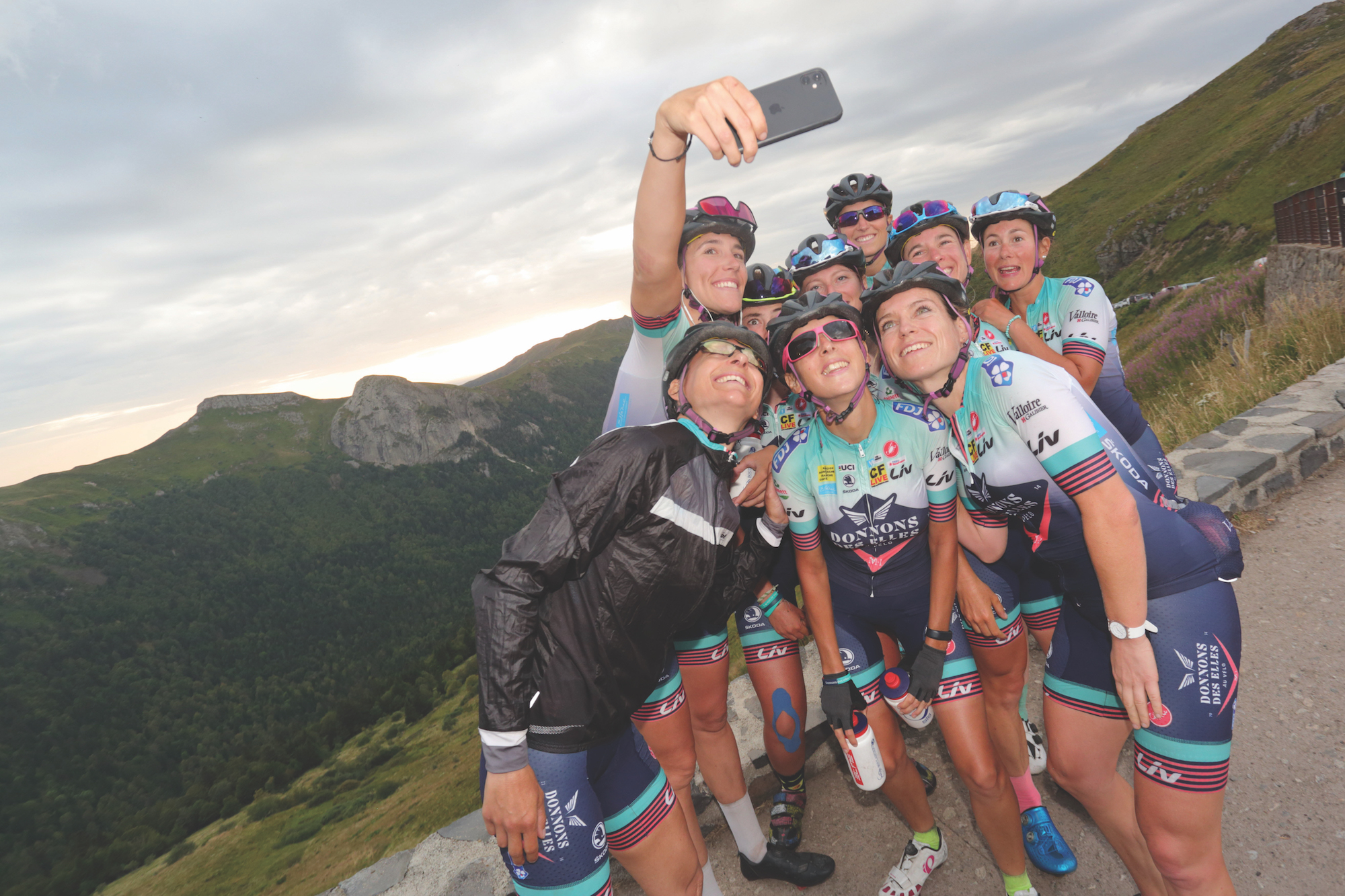
Magali Lagarde says: “The beginning and the end of the climb were the hardest parts. We were greeted by councillors from Mélisey, among them Thibaut Pinot’s father. Thibaut was not present; Covid-19 rules prevented pros from mixing with us. This included the patron of our tour, Cecilie Uttrup Ludwig…but we did spot Pavel Sivakov (Ineos Grenadiers) doing reps.”
Stage 21
Mantes La Jolie – Paris – 78km
Type: Flat
Difficulty rating: ★
Bettina Fischer says: “Our victory parade from the western suburbs to reach the Arc de Triomphe, where police motorcycles escorted us up the Champs Elysées. We’d done it!”
The numbers
Three weeks of riding add up to some startling figures – these are as recorded by Bettina Fischer:
161 Hours in the saddle
3,500 Kilometres ridden
53,934 Metres of climbing
58,107 Calories burned
5 Massages over the course of the three weeks
7 Total number of bottles of water drunk on one col – Grand Colombier and on the Col d’Eze/Quatre Chemins
Support staff
5 physical therapists
2 mechanics
1 motorbike support
1 social network person
1 photographerpreparation
How to get Tour-level fit
Event coordinator Claire Floret, who has ridden the route of the Tour de France for the last six years, provides her top tips for multi-day success:
- Train for a year before the event
- You don’t need to be a road racer, but it is important to be able to cover the distance and ride for a long time day after day
- Do conditioning exercises so that your body can cope with riding long distances every day for 21 days
- Don’t forget the mental aspect. This is also mentally demanding and everyone has a day or two when things get very emotionally challenging.
- Simulate tough situations in your preparation
- The days are long, as you wake up at 6am, finish riding as late as 9pm
- You need to be able to live in a close-knit group as we are two, sometimes three in a hotel room every day and we have no privacy
- It is like being in a professional team, even though we are amateurs!

Thank you for reading 20 articles this month* Join now for unlimited access
Enjoy your first month for just £1 / $1 / €1
*Read 5 free articles per month without a subscription

Join now for unlimited access
Try first month for just £1 / $1 / €1
Maria David is a freelance writer who spent five years living and working in Paris
-
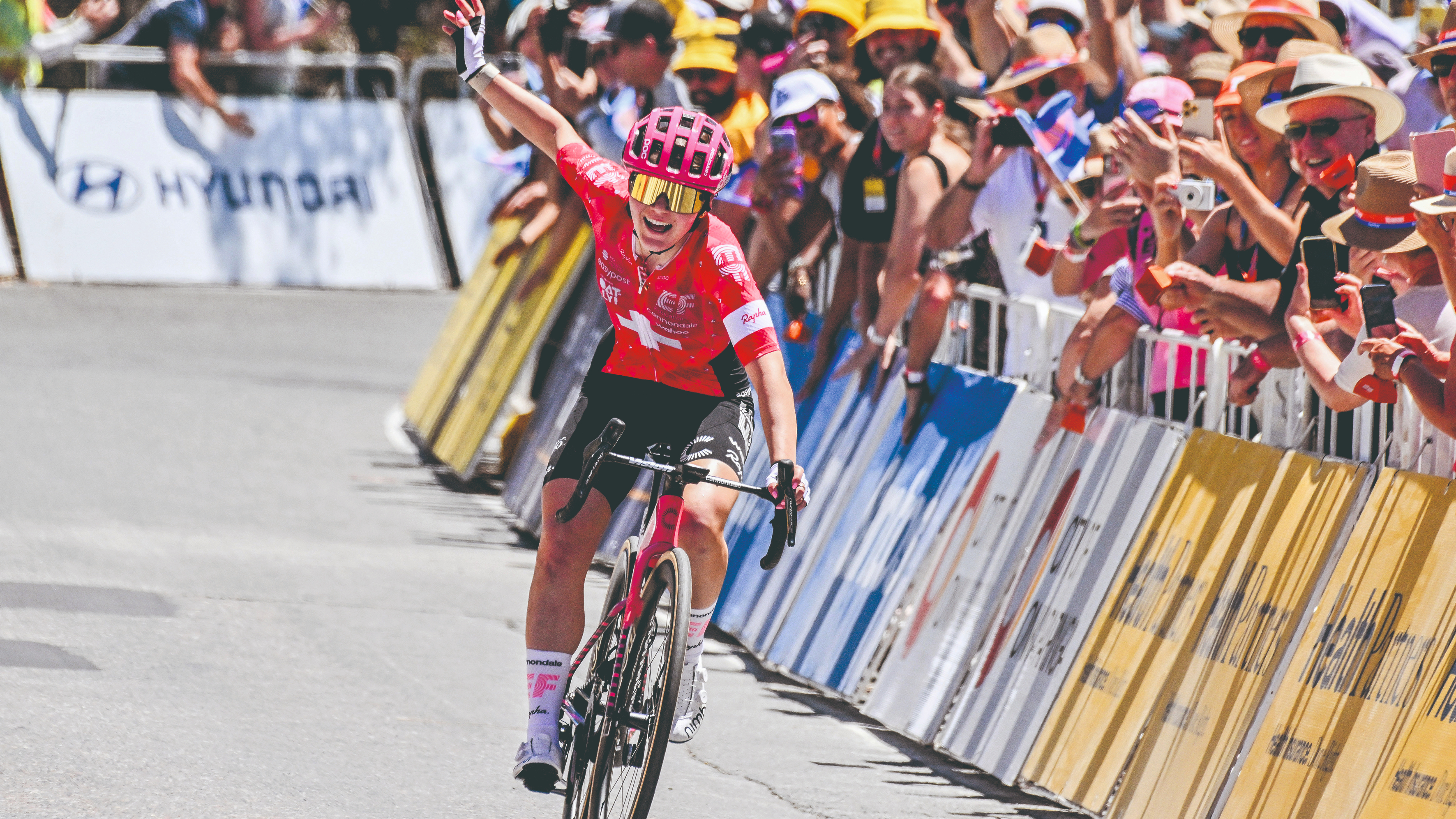 How do the pros train? Noemi Rüegg's 26 hour training week
How do the pros train? Noemi Rüegg's 26 hour training weekWinner of this year’s Tour Down Under, the EF Education-Oatly rider is a climber whose talent is taking her to the top
By Chris Marshall-Bell
-
 Save £42 on the same tyres that Mathieu Van de Poel won Paris-Roubaix on, this Easter weekend
Save £42 on the same tyres that Mathieu Van de Poel won Paris-Roubaix on, this Easter weekendDeals Its rare that Pirelli P-Zero Race TLR RS can be found on sale, and certainly not with a whopping 25% discount, grab a pair this weekend before they go...
By Matt Ischt-Barnard